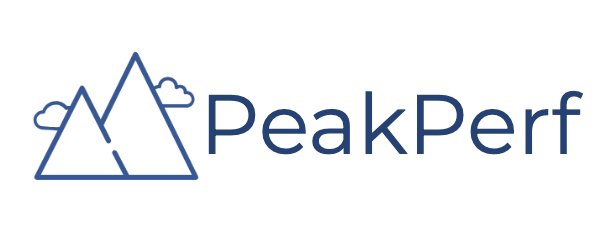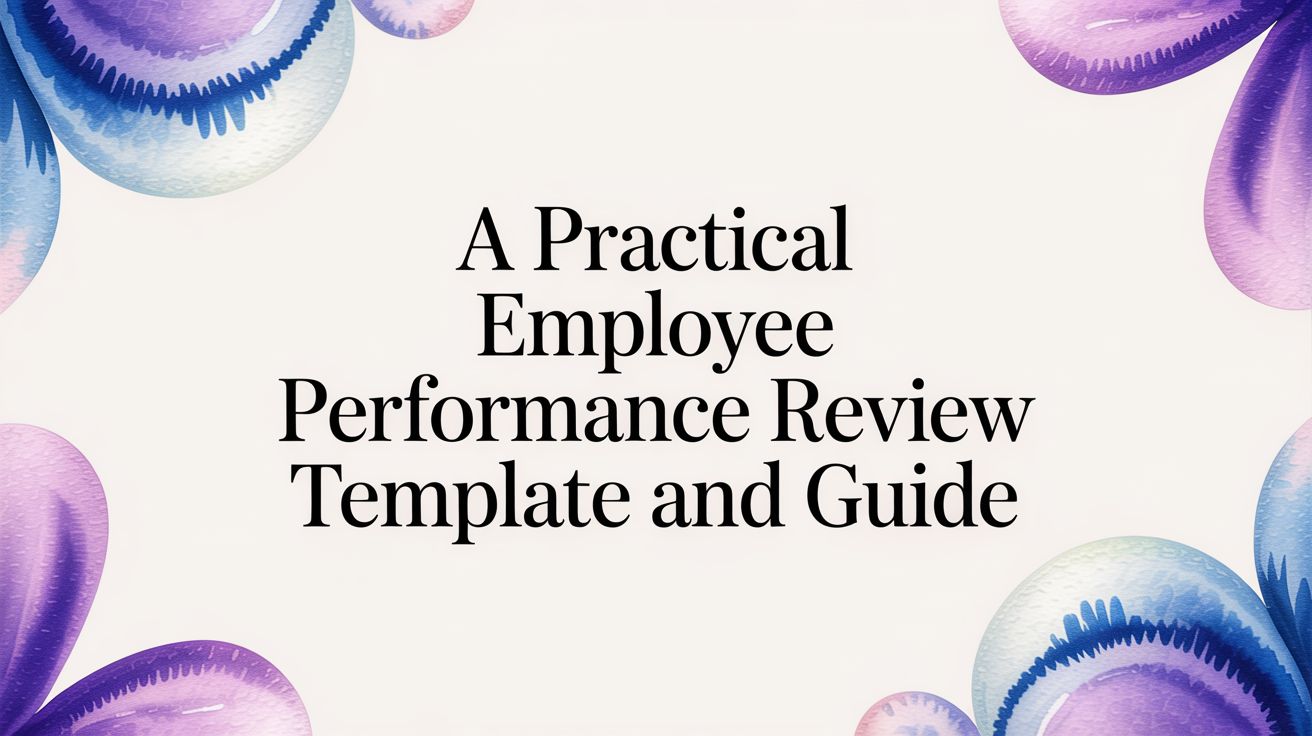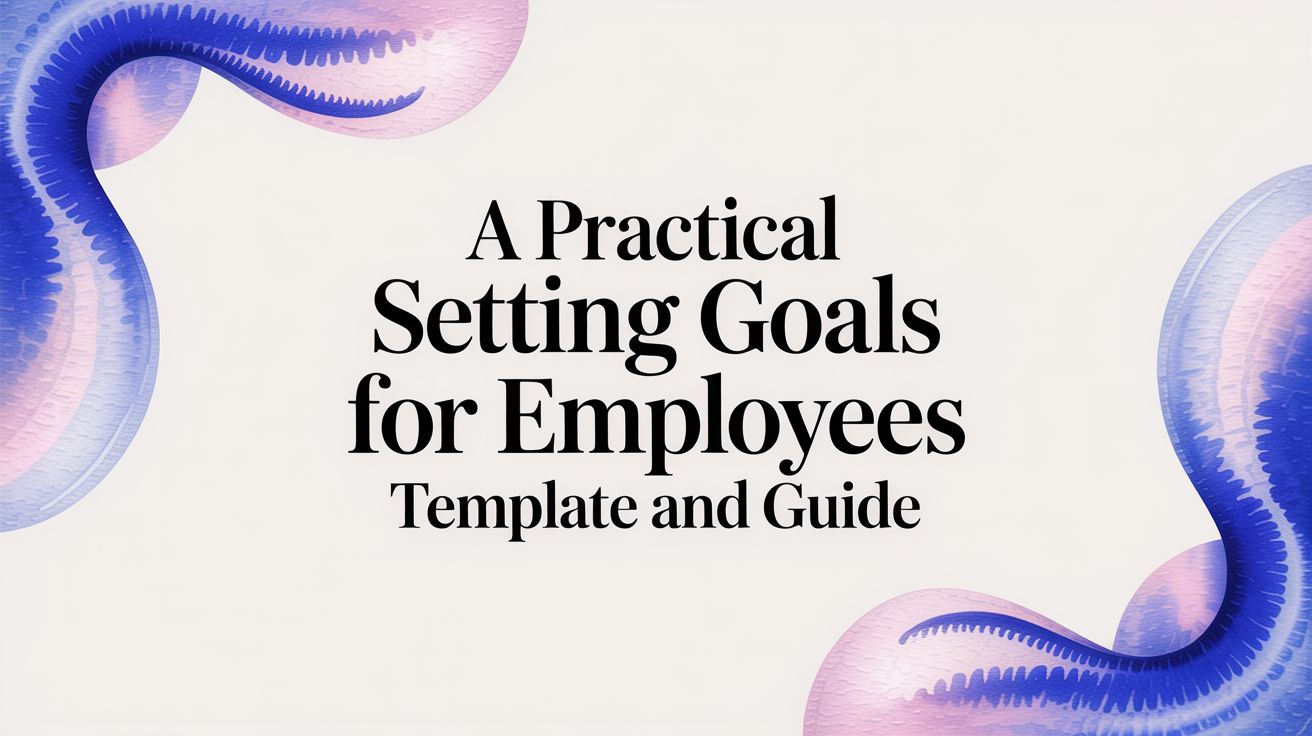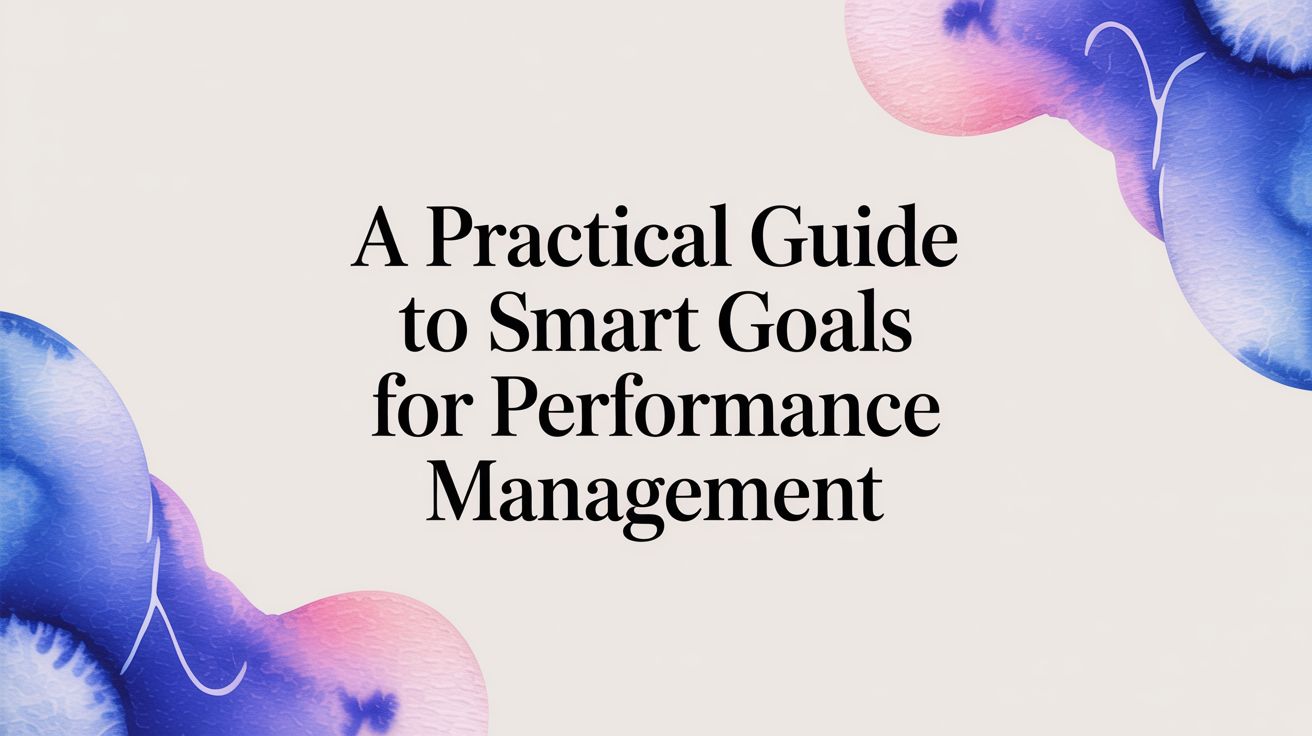How to Have Tough Conversations with Employees: A Manager's Guide
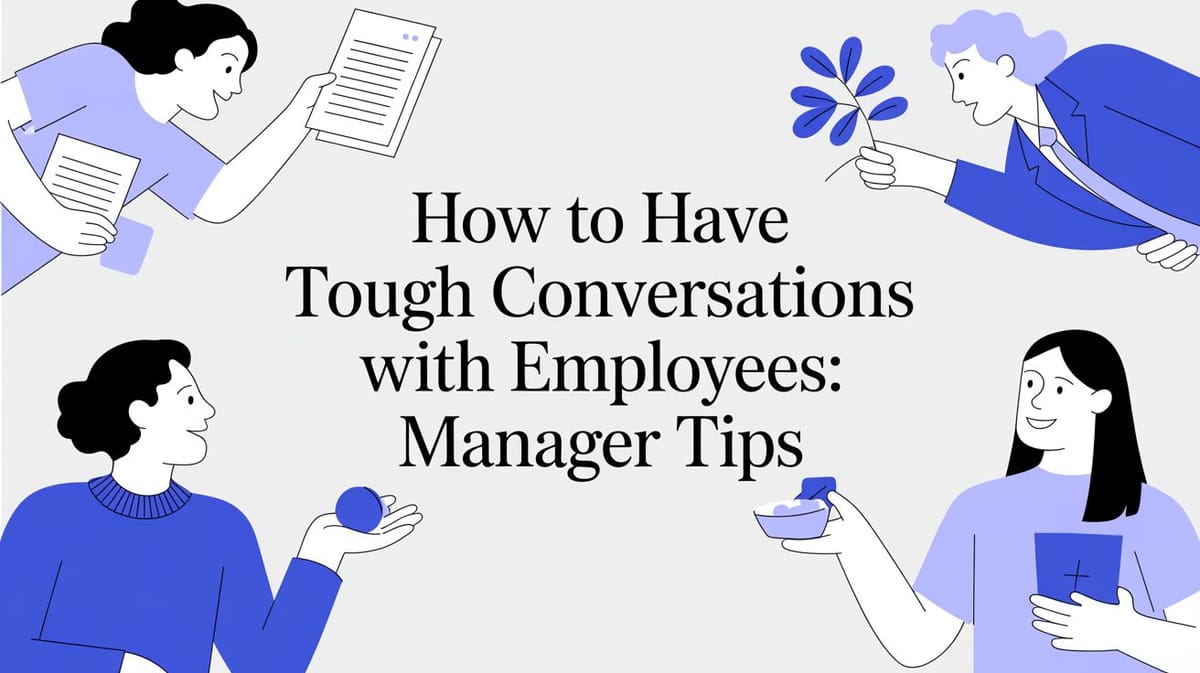
No manager enjoys a tough conversation with an employee. Mastering these discussions is what separates a good leader from a great one. It requires preparation, sticking to facts, and focusing on a constructive path forward instead of assigning blame.
When you handle these conversations well, you solve a problem. You also strengthen your team and stop minor issues from becoming major ones.
Why Tough Conversations Are a Critical Leadership Skill

You will deal with performance gaps, poor attitudes, or team friction. These conversations are part of the job. Your ability to manage these moments with clarity and empathy reflects your leadership.
Delaying a conversation is not a neutral choice. It has real costs that can damage your team's culture and results. Problems left alone always get worse.
The High Cost of Avoidance
Putting off a difficult conversation creates uncertainty. It allows negative behaviors to continue. This directly affects your team in predictable ways:
- Lost Productivity: Unresolved issues and performance problems drain everyone's energy and focus.
- Sinking Morale: When people see problems ignored, they believe standards do not matter or that leadership is indifferent. This leads to disengagement.
- Higher Turnover: People leave managers, not companies. Failing to address problems will push your best people to find a healthier place to work.
These are not theories. Globally, employees spend an average of 2.8 hours per week dealing with interpersonal disputes. In the U.S., this conflict avoidance totals an estimated $359 billion in lost paid hours each year. You can find more workplace conflict statistics to see the impact.
Shifting Your Mindset from Confrontation to Collaboration
The most important step is to reframe your goal. You are not there to confront someone or assign blame. You are there to open a constructive dialogue that leads to a positive change.
Think of these conversations as opportunities for growth. Handled well, they clarify expectations, reinforce company values, and show your commitment to an employee's development.
When you adopt this mindset, the meeting's tone shifts from adversarial to supportive. You are not a judge delivering a verdict. You are a coach helping your employee figure out how to succeed.
This guide is your playbook for these leadership moments. You will learn how to prepare, structure the conversation for clarity, and follow up to ensure improvement. The goal is to give you the confidence to turn these talks into tools for building a stronger, more accountable team.
How to Prepare for a Productive Conversation
A good outcome is decided before you walk into the room. If you rush into a tough conversation unprepared, you create a situation full of defensiveness and misunderstanding. Ordering your thoughts first is the secret to lowering your anxiety and building the structure for a real resolution.
When you do the prep work, you change the dynamic. It becomes a planned, professional discussion instead of a reactive confrontation. That clarity of thought will keep you grounded and focused, even if the situation gets emotional.
Pinpoint the Single Core Issue
First, you must know exactly what problem you are there to solve. Do not make the mistake of tackling multiple, unrelated issues in one meeting. That approach is confusing and overwhelming for everyone.
You need to focus on the one critical behavior or performance gap that must change.
Instead of a vague complaint like, "your attitude needs to improve," be specific. A better focus would be, "In our last three team meetings, you interrupted colleagues while they were speaking." That is the clarity you need.
This precision stops the conversation from becoming a list of past grievances. It keeps the focus tight and targeted on a single, solvable problem, which increases your odds of a good outcome.
Gather Concrete Facts and Examples
Your perspective needs support from objective, observable evidence. Subjective statements are the enemy. Phrases like "you seem disengaged" or "your work is sloppy" invite a debate. Facts are not debatable.
Before you schedule the meeting, pull together specific, documented examples of the behavior. Your job is to describe what happened without emotional language or personal judgment.
- For a missed deadline: "The project report was due on Tuesday at 5 PM. It was submitted on Wednesday at 11 AM."
- For unprofessional communication: "In the team chat on Monday, you wrote the marketing plan was 'a complete joke.' This comment was visible to the entire department."
- For attendance issues: "You were scheduled to start at 9 AM on Monday, Wednesday, and Thursday this week. You arrived after 9:30 AM each day."
Having specific, fact-based examples removes your personal opinion from the equation. It shifts the focus from your feelings about their behavior to the tangible impact of their actions.
This work ensures you can explain exactly what happened and why it is a problem. It gives the discussion a solid foundation, making it harder for someone to dismiss your concerns.
Define Your Desired Outcome
What does success look like here? Before you send the calendar invite, you need a clear vision for the ideal resolution. Without a goal, the conversation will wander and end with tension and no clear path forward.
The goal is not about "winning" an argument. It is about creating positive, lasting change.
Think about what a good outcome could be:
- A specific commitment: "I want you to agree to complete your section of the weekly report by the Friday 4 PM deadline."
- An acknowledgment of impact: "My goal is for you to understand how your comments affect team morale and commit to stopping them."
- A collaborative action plan: "I want us to work together to find what's causing these delays and agree on a new workflow that helps you succeed."
Knowing your destination helps you steer. It gives you a point to return to if the conversation gets sidetracked or heated. This clarity ensures the meeting ends with actionable next steps, not awkward silence.
Structuring the Conversation for Clarity and Action
A clear structure is your best friend in a tough conversation. Without one, the discussion can get sidetracked by emotion or tangents, leaving everyone confused. Think of it as a roadmap that keeps the dialogue calm, focused, and productive.
This framework breaks the conversation into three parts: opening the discussion, explaining the issue with facts, and building a solution together. Following this approach turns a tense meeting into a problem-solving session.
Opening the Conversation Calmly
The first 60 seconds set the tone. Your job is to state the meeting's purpose clearly and calmly, without putting the employee on the defensive. Skip the small talk. It builds anxiety and makes your point feel like an ambush.
Get straight to it, but keep your tone neutral and professional. A direct opening respects their time and shows you are taking this seriously.
Here are a few ways to start:
- For a performance issue: "Thanks for meeting with me. I wanted to talk about your work on the Q3 client project, specifically the deadlines."
- For a behavioral issue: "I asked to meet today to discuss an interaction I observed in the team meeting this morning."
- For a general check-in: "I scheduled this to talk through some concerns I have with the workflow on the accounts you manage."
Notice each example is specific. It centers the conversation on a particular topic, which reduces ambiguity and helps the employee prepare for the discussion.
Explaining the Issue with the SBI Model
Once you have opened, you need to explain the problem. The most effective tool for this is the SBI (Situation-Behavior-Impact) model. This framework removes judgment and emotion by forcing you to stick to observable facts. It helps you deliver feedback that is hard to dispute because it is grounded in reality.
The SBI model forces you to be precise. It is a useful tool, especially when 98% of employees think conflict resolution training is vital, but only 27% of managers are seen as skilled at these conversations. This is a practical way to close that gap.
The SBI model shifts the conversation from "You are the problem" to "This specific behavior created a problem." That distinction is important for keeping the dialogue constructive and ensuring the employee stays open to finding a solution.
Let's break down each piece.
Situation: Describe When and Where
First, you anchor the feedback to a specific time and place. This provides context and makes it feel less like a generalized attack on their character.
For example:
- "During yesterday's client presentation..."
- "In the weekly project update meeting on Tuesday morning..."
- "While reviewing the final budget report you submitted last Friday..."
This first step is simple but critical. It immediately focuses the employee’s mind on the exact moment you are talking about.
Behavior: Detail What You Observed
Next, you describe the specific, observable action. This is the heart of the model. You have to stick to things you saw or heard, not your interpretations or assumptions about their intent.
Here’s how to describe behavior factually:
- "You interrupted your colleague three times while she was presenting her slides."
- "You submitted the report without the required data tables we discussed."
- "You rolled your eyes when the new project timeline was announced."
These are objective statements. They describe actions, not character traits. This is a key part of giving feedback that motivates and corrects instead of discouraging.
Applying the SBI Model to Different Scenarios
The SBI model is versatile. Seeing how it applies to common workplace issues can help you prepare for your own conversations. The key is to always separate the event (Situation), the action (Behavior), and the result (Impact).
Using this structure helps ensure your feedback is always specific, factual, and focused on the business outcome, not personal criticism.
Impact: Explain the Consequences
Finally, you connect the behavior to its tangible impact on the team, the project, or the business. This is where you answer the "so what?" question. It helps the employee understand why their behavior needs to change.
Building on our examples, the impact could be:
- "...The impact was your colleague lost her train of thought, and we had to spend extra time getting the meeting back on track."
- "...As a result, I had to spend two hours finding the data and adding it myself, which delayed the final submission to leadership."
- "...The impact of that was it made other team members feel their contributions were being dismissed and undermined the positive tone of the meeting."
This last piece connects the dots. It shows the direct line between their actions and a real consequence, making the need for change feel clear and compelling.
Shifting to a Collaborative Resolution
Once you have laid out the issue using SBI, the conversation must pivot from problem to solution. This is your cue to shift from talking to listening. Give the employee space to share their perspective, and do not interrupt.
Ask open-ended questions to get a real dialogue going. Try things like, "Can you share your perspective on what happened?" or "What challenges are you facing with this task?" Your goal is to understand their side of the story. You might learn something you did not know.
After you have listened, you can work together on a path forward. The best solutions are almost always collaborative because they give the employee ownership over the outcome.
Focus on agreeing to clear, actionable next steps:
- Define the desired change: Be explicit about what success looks like.
- Identify needed support: Ask what resources or help they need from you to succeed.
- Set a follow-up timeline: Agree on a specific date to check in on progress.
This collaborative approach turns a tough conversation into a development opportunity. It reinforces that you are there to support their success, not just to point out their failures.
How to Handle Tough Reactions Without Losing Your Cool
The most unpredictable part of these conversations is how the other person will react. You can prepare, but you cannot script their emotions. Your composure becomes your most important tool. Staying calm and grounded keeps the conversation from spiraling out of control.
Think of it as having a roadmap. You know where you need to go, from opening the conversation to agreeing on a solution.
When you stick to a logical flow, you are less likely to get pulled into an emotional debate. Instead, you can keep the focus on the facts and on finding a path forward together.
Responding to Defensiveness or Denial
Defensiveness is common. When people feel criticized, their first instinct is to deny the issue, shift blame, or make excuses. Your job is not to win an argument. It is to guide the conversation back to the facts.
When you hear, "That’s not true," or "It was not my fault," take a breath. Do not double down. Instead, calmly bring it back to your SBI framework. You might say, "I understand you see it differently. Let’s walk through the specific example I mentioned one more time."
You need to acknowledge their perspective without agreeing with it. Try saying, "I hear you feel the deadline was unrealistic." Then, pivot back to the consequence: "The reality is the report was late, which had a direct impact on the client presentation. Let's focus on how we can make sure that does not happen again."
This approach shows them you are listening. It also signals you will not get sidetracked from the core issue.
Managing Anger or Frustration
Anger can be intimidating, but the strategy is the same: stay calm. Do not mirror their emotion. If an employee raises their voice or gets frustrated, the worst thing you can do is get angry yourself.
Sometimes, you need to let them vent for a minute. People often need to get frustration out before they can hear you. Listen without interrupting and keep your body language neutral.
Once they pause, you can de-escalate the situation with empathy.
- "I can see this is upsetting for you."
- "It sounds like you’re frustrated with this."
Naming the emotion can take its power away. Once you have validated how they feel, gently steer the conversation back to the problem you are there to solve. Your composure is the anchor that keeps things professional.
Addressing Tears or Emotional Upset
This one can be tough. Crying is often the most uncomfortable reaction for a manager to handle. It is a sign someone feels overwhelmed, embarrassed, or hurt. Your response needs to be compassionate without abandoning the conversation's purpose.
Offer a brief pause. Something simple like, "Let’s take a minute," while offering a tissue or a glass of water can make a difference. It is a small gesture of kindness.
The key is not to back down from the feedback because they are upset. Once they have had a moment to compose themselves, you can gently reaffirm your goal. For instance: "I know this is hard to hear. My goal here is to help you succeed, and working through this is a part of that."
Handling Silence
Silence can feel as intense as an outburst. When an employee shuts down, it is tempting to start rambling to fill the space. Do not.
First, wait. Give them a moment. They might be processing what you said.
If the silence continues, gently invite them back in with open-ended questions.
- "What are your thoughts on what I have shared?"
- "Can you help me understand your perspective on this?"
These questions cannot be answered with a simple "yes" or "no." They make it clear you expect a dialogue, not a monologue, as you work toward a solution together.
Following Up to Ensure Lasting Change
The conversation is not the finish line. A productive discussion is a great start, but real, lasting change happens in the following days and weeks.
Consistent follow-up is how you show you are committed to your employee's success. It holds both of you accountable for the plan you made. Without a clear follow-up process, a constructive conversation can fade from memory, agreements get fuzzy, and momentum is lost. Formalizing the next steps is how you turn good intentions into real, measurable progress.
Document the Conversation with a Follow-Up Email
Immediately after your meeting, send a brief, factual email that summarizes what you discussed. This is not about writing a long transcript. It is about creating a clear, written record of the key points, the actions you both agreed to, and the timeline for your next check-in.
This document does two critical things. First, it eliminates misunderstanding by putting everything in writing. Second, it creates a trail of accountability that protects both you and the employee, making expectations clear. Keep the tone neutral and focused on moving forward.
A follow-up email transforms a verbal agreement into a shared action plan. It removes ambiguity and provides a concrete reference point for future check-ins. It is one of the most critical steps in the process.
Your email should be simple and direct. It is a confirmation of your shared understanding and sets the stage for the next phase of support and evaluation. Do not underestimate this step. It can be the difference between a temporary fix and a permanent improvement.
Simple Follow-Up Email Template
Here is a straightforward structure you can use to create a clear and effective summary of your conversation. The goal is to be concise while capturing all essential details. This approach ensures your documentation is professional and keeps the focus on action.
This template provides a clear, actionable record that keeps everyone on the same page and sets a positive tone for the path ahead.
Schedule a Formal Follow-Up Meeting
The email sets the stage, but a dedicated check-in meeting is where you will see how things are going. Schedule this meeting during your initial conversation so it is on both of your calendars right away. The right timing depends on the issue, but a one or two-week follow-up is a common starting point.
Think of this meeting as a progress review, not another tough talk. Your main job is to listen, offer support, and give more feedback.
Come prepared with specific observations you have made since your last talk.
- Acknowledge positive changes. Start by recognizing any effort or improvement. "I noticed you have been providing daily updates as we discussed, and it has been a great help."
- Ask about challenges. Find out what is getting in their way. "How has the new workflow been feeling? Are there any obstacles I can help remove?"
- Provide coaching. If the issue is still there, use this time to offer more targeted guidance or point them toward helpful resources.
For situations that demand more structured monitoring, you might need to introduce a formal Performance Improvement Plan. If you are in that spot, our guide on how to write a Performance Improvement Plan has detailed steps and templates to walk you through it.
These consistent check-ins show you are invested in your employee's growth and reinforce the importance of the changes you discussed.
Your Toughest Questions, Answered
Even the best plans can have problems. In the moment, specific situations pop up that can leave you unsure of how to proceed.
Let's walk through some of the most common questions managers have about these conversations. Having clear answers ready will give you the confidence to handle what comes your way.
How Much Detail Is Too Much?
You are trying to find the balance between being specific and overwhelming the employee with a list of every past mistake. It is a fine line.
Your goal is to provide 1-3 clear, recent, and fact-based examples that get to the heart of the issue. That is all. Resist the urge to bring up something that happened two years ago or nitpick every minor error from last week.
If the problem is missed deadlines, focus on the most critical ones and their direct impact. This keeps the conversation focused and productive. Drowning them in examples will trigger a defensive reaction, and nobody wins.
The point of sharing examples is not to prove you are right. It is to help the employee see the specific behavior and its consequences so they have the clarity to make a change.
What if They Blame Someone Else?
An employee will likely deflect, pointing a finger at a coworker, another team, or a flawed process. It is a normal human reaction.
When this happens, your job is to acknowledge their point without letting the conversation get derailed.
You can say something like, "I appreciate you sharing that context, and we can talk about team processes later. For right now, I want to keep the focus on your role in this and what you can control." This phrase validates their concern while gently steering the conversation back to their accountability.
Should I Bring in HR?
Deciding whether to have an HR representative in the room is a strategic call. It depends on the severity of the situation.
Here's a quick guide:
- For standard performance coaching or minor behavioral tweaks: You can handle these one-on-one. It is usually better that way.
- For serious misconduct or anything with legal risk: Always involve HR. This includes any discussion about harassment, discrimination, safety violations, or a potential termination.
- If you expect a highly emotional or hostile reaction: Having a neutral third party like an HR partner can be helpful. They can de-escalate tension and ensure everything stays professional and properly documented.
When in doubt, have a quick chat with HR beforehand. They can advise you on company policy and help you figure out if their presence is needed to protect the employee and the organization. Their involvement ensures the process is fair, consistent, and legally sound.
Preparing for these leadership moments takes time and practice. PeakPerf is a management toolbox that helps you prepare for tough conversations in minutes, not hours. It guides you through proven frameworks like the SBI model to create structured, professional drafts that reduce your stress and lead to better outcomes. Build your confidence and start having more effective discussions today. Find out more at https://peakperf.co.
